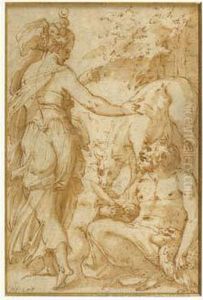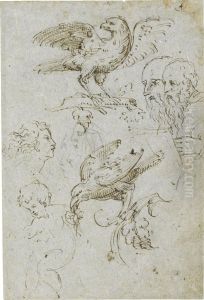Cristifano Doceno Gherardi Paintings
Cristofano Gherardi, also known as Cristofano di Lorenzo Gherardi or, by his nickname, Doceno, was an illustrious Italian painter and decorator born in 1508 in Borgo San Sepolcro, Tuscany, during the High Renaissance. Although not as universally known as some of his contemporaries, Gherardi's contributions to Italian art, particularly in fresco and mural painting, were significant during the 16th century, a period that witnessed the flourishing of the Italian Renaissance.
Gherardi's artistic journey began under the guidance of his father, who was also a painter, and later, he became a pupil of Rosso Fiorentino, a master whose Mannerist style greatly influenced the young artist's development. Gherardi's work is characterized by its dynamic compositions, vibrant use of color, and the incorporation of Mannerist elements, which was a style that emerged in the late Renaissance period that sought to evoke emotion and used exaggerated perspectives and proportions to create drama and tension in the artwork.
Throughout his career, Gherardi collaborated with many notable artists of his time, including Giorgio Vasari, with whom he worked on the decorations of the Palazzo Vecchio in Florence. His contributions to this project, particularly in the Sala dei Cento Giorni, are among his most celebrated works. Additionally, Gherardi's frescoes in the cathedral and other churches of his native Sansepolcro demonstrate his mastery of religious themes and his ability to imbue his subjects with a sense of divinity and transcendence.
Despite his achievements, Gherardi's work was somewhat overshadowed by the luminaries of his era, such as Michelangelo and Raphael. Nevertheless, his artistic legacy is significant, especially in the realm of fresco painting, where his innovative techniques and expressive style left a lasting impact. Gherardi's ability to blend the grandeur of the High Renaissance with the emotive qualities of Mannerism makes his work a fascinating subject for study among art historians and enthusiasts alike.
Cristofano Gherardi passed away in 1556, leaving behind a body of work that, although not as widely recognized as that of some of his peers, remains an important part of the Renaissance art historical narrative. His contributions continue to be appreciated for their artistic merit and historical significance, offering insight into the transitional period between the High Renaissance and Mannerism in Italian art.

